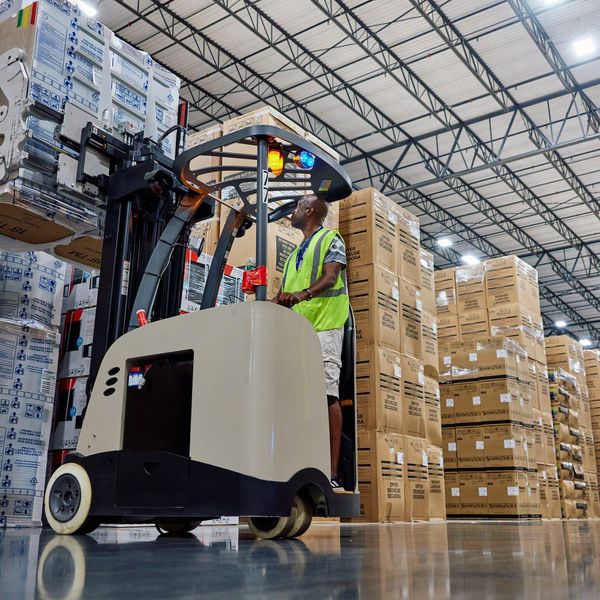Expert Tips to Optimize Warehouse Efficiency and Productivity
Optimizing warehouse processes can have a big impact on your bottom line and enhance service to your customers

As real estate prices increase, the area within the four walls of the warehouse is at an ever-greater premium. Effective and efficient warehouses can help maximize space, increase productivity and improve performance, making the most of your existing warehouse space. Optimized warehouses also make the most of available labor and ensure timely service. From improving slotting patterns to embracing technology, there are several ways to streamline the movement of goods within your warehouse.
Explore these strategies from the experts at Penske Logistics to optimize your warehouse:
Improve Slotting Patterns
Optimal slotting patterns place high-velocity pick items as close to the door and as tightly together as possible to drive efficiency. Optimal slotting designs are based on historical sales data, including volumes and A, B, C and D movers, along with forecasted demand and seasonality. That data will provide insight into what to stock and where to position it to get the top movers out of the door faster. It isn’t hard to move slotting patterns as demands change, and adjustments should be completed at least once a year to ensure efficiency. Some industries, such as food and beverage, change slotting patterns seasonally.
Separate Fulfillment Channels
The growth in e-commerce means more and more warehouses have three fulfillment channels: shipping to their own locations, outside retail locations and business-to-consumer. Depending on the volume or the way warehouses receive orders, there can be a pallet area, case-pick area, and an each-pick area to maximize each category’s efficiency.
Find the Ideal Racking Solutions
The right storage solutions are often based on the cost of specific geographic locations, which varies. Space is much more expensive in California than in the Midwest, so in California warehouses, it might make sense to invest in vertical racking. Sites can utilize single-deep racking, double-deep racking, push-van racking or other types to get additional spots on the rack.
Examine Labor Standards
Labor is central to warehouse operations and software can help manage the movement of people and track productivity. That data can be compared to warehouses’ labor management time standards and results should be evaluated every day after every shift to ensure employees are meeting their productivity standards.
Utilize a Robust Warehouse Management System
A warehouse management system provides inventory visibility and tracking and ensures products don’t get mixed up or misplaced. Improving your warehouse management software can provide several benefits, including the traceability of products, which will become even more important for certain industries, such as food and beverage, that have increased safety standards.
Invest in Technology
Various technologies can help improve operations within the warehouse. Some warehouses use a voice-pick system to help pick items more efficiently and employees can close out orders as they pick them, using their voice and an index finger scanner. Radio frequency scanners, including forklift mounts, handhelds and wearables, direct employees to the correct picking location. Once employees pick the products, the system automatically updates the picked items in the warehouse management system.
Augment Labor
Drones and visual guided vehicles can help free up human talent to focus on more important tasks within an operation and improve overall safety. Drones can fly through a distribution center’s aisles and provide updates on inventory or alerts if products are not in their assigned slot. Visual guided vehicles can be used to move pallets or other inventory throughout the warehouse and are trained to run the same pattern.
Create a Contingency Plan
Supply chain disruptions have highlighted the need for contingency planning, which can range from preplanning for a natural disaster to knowing how to ramp up operations if there is a spike in business. Thinking through and predefining potential scenarios can ensure an efficient shift when necessary.
Utilize a Multi-Client Warehouse
Companies looking to expand their footprint and move inventory closer to end consumers are turning to multi-client warehouses, which enable them to take advantage of smaller space within a facility. Multi-client solutions make sense for customers needing 75,000 square feet of space or less.
Realize the Benefits of Warehouse Optimization
From efficiency improvements, lowered operating expenses, enhanced worker productivity and reduced turnover to greater inventory management and better customer service, the benefits of a solid warehouse optimization plan are significant. Ensuring you have the right processes and platforms in place can help your business run more efficiently than ever before.
There are many elements to choosing the right logistics partner. Penske places a premium on taking the necessary time to clearly understand how our logistics solutions may impact the entire company. Our goal is to ensure the efficiencies provided by Penske are realized at virtually every level.
For more information on what Penske Logistics can do for your organization, please contact us at 800-529-6531.
